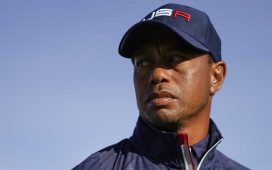AUGUSTA, Ga. — There are longer holes at Augusta National Golf Club, more difficult holes, holes with more bunkers and azaleas, holes where more dramatic moments, revisited each spring until eternity, are seared into Masters Tournament history.
None of them jangle nerves and shatter dreams like the par-3, 12th.
No. 12, Golden Bell, is the fourth most difficult hole in Masters history (3.28 stroke average). The green is officially 26 yards deep, measuring from front the left right portion to the back right corner. But that number is misleading. The hourglass shaped green is complex. Angling away from the tee box from left-to-right is no deeper than 14 yards at any point. Even for the best players in the world it’s a small window to find from 155 yards away.
And that’s on a rare calm day.
Justin Thomas, considered the best iron player in golf, made birdie on the 12th Friday in calm conditions. Despite his impeccable distance control and command of trajectory, his goal upon arriving at the 12 tee is modest.
“All I try to do is hit the green,” Thomas said. “That’s the only thing I’m worried about. I don’t care where the pin is or what the number is. I’m just trying to flight something and put it on the green.”
The breakdowns and disasters at the 12th have a permanent place in the tournament’s tradition.
Greg Norman in 1986. Jordan Spieth in 2016. Francesco Molinari and other contenders in 2019. Each watched their Masters dreams drown in Rae’s Creek in front of the 12th green. The adage applies, as tired as it may sound: a player can’t win the tournament on the 12th; he can most certainly lose it there.
In 1980, Tom Weiskopf made a 13.
In the last two decades, golfers have benefited from unprecedented improvements in fitness, instruction and equipment. The 12th remains a riddle. The only man to solve the 12th – at least for one week – is Scott Verplank, who made four consecutive birdies there in 2002 and finished in the top 10.
The hole holds up, as is, no new tee box or tier in the green required. Officially, the last change to the 12th hole occurred in 1965 when the club built split level side-by-side tees. The players notice subtle shifts from year-to-year.
“There’s little tricks that the championship committee will kind of play and look to enhance the architecture and enhance the playability,” Paul Casey said earlier this week, prior to his 15th Masters. “And 12 is one that hasn’t been immune. It’s changed around the edge of the greens but the strategy kind of remains the same.”
Masters: Leaderboard | Photos | TV, streaming info
“A pin on the left, you can be very aggressive. A pin in the middle, very aggressive. And the pin on the right, you leave it alone,” Casey said. “It’s pretty much as simple as that. And the yardage only ever alters literally a handful of yards, but it’s that beautiful way that the elements create the indecision on that hole with the way the wind swirls.”
Ah, the wind.
Any discussion of No. 12 is incomplete without discussing the diabolical wind. The hole sits in the middle of Amen Corner, on the lowest ground of the property. Towering pines and oaks form a border on the left, framing Hogan Bridge, and behind the green form a buffer between Augusta National and Augusta Country Club. Azaleas, dogwoods and ornamental shrubs color the hillside that’s covered in pine straw. Three bunkers — one in front and two in the rear — guard the putting surface and Rae’s Creek swallows shots short of the green.
Behind the tee is a mild embankment where patrons gather. To the left of the 12 tee is the 11th green. The open space and landscape creates a unpredictable wind pattern. A golfer gazes at the trees, hoping for clues. He looks to the heavens for validation or inspiration. He turns over his shoulder to study the flag on 11. He tries to trust his caddie even when what he’s seeing and hearing don’t align.
On a windy day years ago, Lucas Glover asked his caddie Don Cooper which way it was blowing.
“Clockwise,” Cooper said.
John Wood caddied in 20 Masters, working for pros Mark Calcavecchia, Hunter Mahan and Matt Kuchar. He believes the horrific side of the hole’s history plays a role in the difficulty of what’s rarely more than a 9-iron shot for the modern player.
While players must remain in the moment at Augusta National, paying careful attention to only the shot at hand, a caddie can peer forward and start solving the next problem. Wood always looked toward the 12th while walking down the 11th fairway, taking note of ball flight and shot results in the groups immediately ahead.

The 12th hole at Augusta National Golf Club is called Golden Bell. (Photo: Patrick Smith/Getty Images)
“Thursday or Friday you could maybe see six shots into that hole before you get there,” said Wood, now an on-course commentator for NBC Sports golf coverage. “The side view is the great vantage point to watch balls in the air, even if I couldn’t see the groups ahead of me and see where they were playing from, seeing where their ball landed around the green helped confirm what the wind was doing.”
This year, approximately half the field found the green in regulation through the first three rounds. Once they did, the green, which is the flattest on the course, was also the easiest to putt. But through the years, when the hole location is cut in the right quadrant of the surface on Sunday, the leaders rarely make putts of a significant distance.
“I feel like the biggest thing with trying to read the putts on 12 is not only is it kind of subtle, but at the same time being there near the trees you get a lot of shadows,” said 2018 champion Patrick Reed, who is 3-over on No. 12 in 27 Masters rounds. “So you go a lot of times from sunshine to shadow to sunshine, and trying to read putts through different conditions, especially different light, makes it a lot more difficult not only just to figure out the grain but also figure out the exact break.”
Most players aim over the front bunker every day, never moving their line farther to the right. As Phil Mickelson pointed out earlier this week, lefthanders have an advantage in the final round because they can hit a stronger ball flight, a draw, to the traditional Sunday hole location.
An element of feel feeds the final decision.
“That’s just one of those holes that it’s hard to sit there and have a game plan, when wind and how you’re hitting the golf ball that day and kind of where you stand in the tournament, what the pin placement is,” Reed said. “I think the biggest game plan there is you put a big red X on the water. You try to avoid that at all costs, whether hit it in the bunker or over the green and figure out how to get up-and-down or have a chance to make birdie.”
In 85 years of the Masters Tournament, 339 rounds and more than 20,000 tee shots, only three players have made an ace on 12. The field has combined for 630 double bogeys or worse at 12 since Curtis Strange made the last hole-in-one there, in 1988 from 155 yards with a 7-iron.
Wood, the veteran caddie, said the hole plays most difficult when the wind is blowing left-to-right or in the player’s face and timing the shot is important on the tee. A player may need to accelerate his usual pre-shot routine so he can strike the ball when the wind, his club selection and shot shape agree.
“Ultimately at the end of the day it’s trusting and trying to hit that shot because if you feel anything different and you come out of the shot and you slightly miss it, that’s when things can go wrong,” Englishman Matt Wallace said. “As long as you stick to your shot that you choose, that’s the most important thing to do.”

Tiger Woods walks across the Hogan Bridge to mark his ball on the 12th green after play was suspended during the second round of The Masters at Augusta National Golf Club. (Rob Schumacher/USA TODAY Sports)
Photographed as frequently as a President or a prom date, positioned in the heart of iconic Amen Corner and poised as a final round turning point each spring, the 12th is the shortest par-3 at Augusta National, the most difficult and for some, the most beloved.
“Look, it’s a beautiful example that golf holes don’t need to be long to be treacherous and exciting and difficult,” Casey said. “They create — that’s a great hole that creates fear in players, but I love it. It’s one of my favorite holes on the golf course.”








